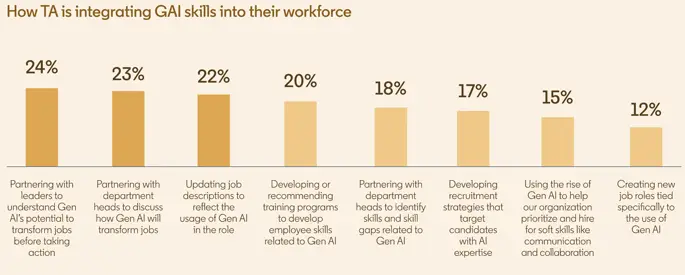6 Predictions for Hiring Practices in 2024 and beyond
Due to the power of artificial intelligence (AI), the workplace is transforming in ways we couldn’t have imagined just years ago. Adapting to this quick emergence of Gen AI, the increasing number of return-to-office mandates, economic uncertainty, and intense competition for personnel with specialized skills are reshaping the talent landscape.
In this Aniday guide, we outline six key predictions that will shape the future of talent acquisition, giving TA teams the insights they need to succeed. Backed by LinkedIn data, these predictions offer a clear roadmap for thriving in the evolving world of recruitment.
Prediction 1: AI will accelerate hiring
When we asked talent leaders about the key trends shaping talent acquisition (TA) in the coming year, one answer stood out: Generative AI, due to its numerous benefits.
Boosting Recruitment Efficiency with Gen AI
Using Gen AI often helps us its biggest advantage: speeding up and simplifying the process of writing job descriptions. By automating routine tasks, AI frees up your time for more important work, boosts productivity, and enhances your ability to engage and connect with candidates more effectively. Moreover, gen AI adoption is expected to grow as many recruiting teams learn to leverage it for sourcing candidates, personalizing outreach, and matching internal candidates with open roles.
 (Source: LinkedIn)
(Source: LinkedIn)
Enhancing the Impact of Talent Acquisition
In this Gen AI era, talent acquisition is set to undergo a major shift, elevating the role of TA within organizations. This transformation also highlights a unique chance for the team to take the lead in integrating skills into the workforce.
Many companies are embracing a collaborative approach to integrating Gen AI into their workforce by partnering with leaders and department heads. This strategy allows you to explore how Gen AI can transform roles and enhance efficiency before making key decisions.
Besides, Gen AI can also free up your time to focus on strategic priorities, including implementing skills-based talent strategies and advancing diversity, equity, and inclusion (DEI) initiatives.

(Source: LinkedIn)
Tips & Strategies:
- Motivate recruiters to try out AI experiments
- Make responsible use of AI
- Keep abreast of the changing legal scene
Prediction 2: Recruiting will play a key role in shaping the skills-driven workforce
As we observed, employers these days understand that maintaining competitiveness requires putting skills first when it comes to hiring and developing staff. By moving away from the standard qualifications, companies can expand their talent pools and discover candidates they might have overlooked.
Enhancing diversity via skill-based employment
By prioritizing skills, you can not only identify the most qualified candidates but also open doors for individuals from historically underrepresented groups who may not have formal degrees. In fact, LinkedIn data shows that focusing on skills can expand your candidate pool by up to 10x.
With 80% of recruiters aiming to build a more diverse workforce, skills-based hiring is gaining traction. You can take the first step by simply removing degree requirements from your job descriptions, something many companies are already doing.

Upskilling employees to address the skills gap
In Southeast Asia, 67% of recruiting professionals say their organizations are actively evaluating the talent and skills needed to stay ahead with the rise of AI. Therefore, by providing upskilling opportunities, you can not only address critical skills shortages but also enhance employee retention within your team.
To make sure that your company has the proper internal mobility and upskilling programs in place, you need to take on the role of talent adviser. Therefore, you can make sure your talent is prepared for the future and meet the changing expectations.
Tips & Strategies:
- Present a case for hiring people based on their talents.
- Look for applicants based on their skill set.
- Encourage initiatives for internal mobility and upskilling.
Prediction 3: Prioritizing the quality of hire will shape the future of recruitment
It turns out that quality is measurable. Many companies are leveraging data to enhance their hiring processes and minimize employee turnover, an issue that can be costly for every employer.
Measuring quality of hire
As the importance of hiring quality increases, Aniday knows that tracking and measuring it remains a significant challenge for many companies. To tackle this effectively, you need to define what constitutes a “quality hire” within your organizations and determine the key metrics they will assess. Here are some crucial factors that you can consider:
- Job Performance: How well does the new employee meet or exceed specific goals and objectives tied to their role?
- Team Fit: Is the new hire enhancing the team's agility and effectiveness in getting work done?
- Culture Add: Are the new hire’s values aligned with your organization’s principles and mission?
- Productivity: Is the individual hitting their productivity targets?
- Retention: The length of time an employee remains with your company can indicate hiring quality, although various factors can affect their tenure.
The definition of “Quality of hire” is changing
Soft skills are becoming more and more valuable to employers because they are the key competencies that enable productive relationships at work. Actually, soft skills like leadership, communication, and critical thinking make up six of the top 10 skills on LinkedIn's list of most in-demand abilities. More importantly, the job market is increasingly seeking candidates whose values align with the company's mission and core principles, ensuring a deeper connection and long-term success.
Tips & Strategies:
- Put into practice unbiased, fact-based candidate evaluation procedures.
- Examine your hiring procedure.
Prediction 4: It will be essential for recruitment teams to possess agility
LinkedIn survey responders also emphasized one important point, which is that recruitment teams want to improve their capacity to assist their companies in navigating labor market volatility and quickly adapting to changing circumstances.
Preparing hiring teams for the future
A remarkable 97% of recruitment professionals in SEA emphasize flexibility as their mian goal, aiming to swiftly adapt to the rapidly changing hiring demands of today’s market and the evolving needs of their organizations.
Cross-functional recruiters are becoming more common
As the landscape of talent acquisition evolves, TA professionals are expected to become "full-stack" recruiters who navigate seamlessly across various functions and stages of the hiring process. This shift highlights clearly on LinkedIn data, showing that recruiters are now broadening their skill sets and breaking free from the traditional silos that once defined their roles.
Previously, the skills associated with different recruiting roles were quite distinct. However, as roles have become more cross-functional due to a significant overlap in skill sets. This means you can easily pivot from one functional area to another as the situation demands, enhancing your versatility and effectiveness as a recruiter.
Tips & Strategies:
- Remove HR silos.
- Keep track of the strategic objectives and business success of your organization.
- Hold planning meetings for scenarios.
- Spend money honing the abilities of recruiters
- Cross-functional recruiters are becoming more common.
Prediction 5: Sales teams will promote flexible work schedules
 (Source: LinkedIn)
(Source: LinkedIn)
The flexible hybrid work model offers significant benefits that far outweigh the traditional full-time onsite approach. By embracing flexibility, you can enjoy a larger talent pool, attract more applicants, and enhance your employer brand. This modern approach also creates a more appealing work environment for potential employees.
There will always be a need for flexible work
Flexible work has emerged as a crucial employee value proposition (EVP) in recent years, especially among Gen Z. The significance of flexible work in EVPs has risen by 10% across all job seekers and an impressive 22% among Gen Z candidates between 2021 and 2023.
If your company includes this work policies, you can enjoy a substaintial hiring advantage, because there is a 29% increased likelihood of receiving applications from candidates who view their job postings.
Interest in remote roles remains strong, even though the number of fully remote positions has declined. This trend highlights the ongoing demand for flexibility in the workplace and its impact on attracting top talent.
Influencing recruiting managers and policy makers
As a hiring professional, you’re probably well aware of the growing demand for flexible work, as you hear directly from candidates. While you may not set the company policies, you can still advocate for flex work by sharing real-time data or providing success stories of remote employees thriving in their roles.
Tips & Strategies:
- Make yourself known as an informed talent advisor on flex work
- Use data to make your case
Prediction 6: A fresh strategy will be needed to draw in Gen Z
By 2025, Gen Z will comprise more than the quarter of the global workforce. However, many recruiting professionals are uncertain about their ability to attract and retain this newest generation of talent.
Employers are investing more on their employer brands
Employer branding is expected to experience the biggest increase in investment, with 57% of recruiters planning to boost their spending in this area.
To succeed in attracting and retaining Gen Z talent, you need to truly understand their unique traits. Having grown up during a global pandemic, social justice movements, and the climate crisis, Gen Z is passionate about working for companies that share their values.

Gen Z desires a job that allows them to grow and thrive
In Gen Z perspective, the opportunity for professional growth stands out as a top priority, surpassing competitive compensation, work-life balance, and flexibility. In Southeast Asia, Gen Z are an impressive 94% more likely than Gen X and Millennials to seek out companies that offer skill development opportunities.
As a Talent Acquisition professional, it's essential for you to authentically communicate not just the organization's values, but also those of the hiring manager. This genuine approach will help you attract the right candidates who resonate with both sets of values.
Tips & Strategies:
- Make sure the employer branding you use is genuine.
- Educate hiring managers on the distinctive qualities of Generation Z.
- Aim for a candidate experience that is effective.
- Aim for a diverse range of generations.
End notes:
Keeping up with these rapid changes in the recruitment industry can be challenging. You must embrace a growth mindset, be open to acquiring new skills, and leverage technologies.
Searching for top-notch Employer of Record (EOR) services? Look no further! Aniday offers outstanding EOR solutions tailored to your needs. Reach out to us today—whether directly or through our headhunting services—and let’s elevate your hiring experience!
We hope these collective insights empower you to stay ahead and thrive in the future of recruitment!
Source: LinkedIn
Aniday's HR Services
Headhunting Service
Find and recruit quality candidates in just 1 week! Supported by 40,000 experienced headhunters in IT, Finance, Marketing… capable of recruiting in any region.
Headhunting Service ➔Employer of Record (EOR) Service
On behalf of your business, we recruit employees and handle payroll without the need to establish a company in markets such as Vietnam, Singapore, Malaysia, India, Indonesia…
Employer of Record (EOR) Service ➔